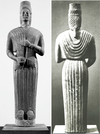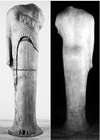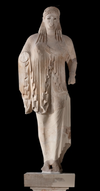KORAI - in details Flashcards
(41 cards)
Which Kore we have (we’ve discussed) colored restavrations?
- Phrasikleia
- Peplos Kore
Which Kore have polos?
- Berlin
- Phrasikleia
Which Kore wear peplos with sleeves?
- Berlin
- Peplos Kore
Which Korai have the most outstanding drapery rendering? Why?
- Antenor’s Kore : the mental is coming down in fussy parallel folds and its wavy edge is grooved with different depth >> play of light, sense of weight.
- Kore 675 :
Which Korai have their skirts :
a) realisitcally reacting to the pull?
b) plastic-looking?
a. Phrasikleia
b. Antinor’s; Kore 675
Describe :
BERLIN KORE
Berlin Kore, ca. 580 - 570 BC, found at Keratea in Attica, 1. 93 m :
- was wrapped in led;
- as a mythological figure connected to rebirth, could be funerary;
- approach :
same as early Kouroi : not much follow through
- stance :
- frontal & straight;
- arms - bent, but dont interfere with the rectangular-block technique;
- clothes - as stelai;
- body:
- feet - huge (invisible from behind);
- hands :
- right - pommwgranate;
- left - on the chest : thumb - tucked in; similar position as with Daedalic statue;
>> moving limbs from the very beginning of the series << probably, because of the offering she is holding, present for the deity:
instead of going to the sanctuary with one offering once at a certain day, statues – permanent offering (both the object she is holding and she herself).
- clothing :
- peplos + sleeves:
skirt - broad folds;
- epiblema on top:
- very decorative: front - symmetrical ; back - huge sawgs bigger to the bottom (to accomodate hair)
>> heavy material.
- like Kouroi’s hair : n_o realistic response_ to the body;
- no body underneath;
- sandals >> shoes are meaningful;
- hat : box-like, Polos - straight sides << place for decoration, e.g. meander (aka “Greek key”) is carved on the bottom:
Polos - Eastern hat : usually, the wearer - a figure of some status, sometimes – goddess;
BUT Greeks could have borrowed this detail without borrowing the meaning – no images of goddess in Greek world with this type of hat.
- head :
- face : very oval, typically Archaic.
- eyes : bulging; stylized like Kouroi’s but with a very deep groove.
- nose : very long, pronounced
- hair :
- front : curls + vertical grooves = as smooshed snail curls;
- behind the ear :
- smooth;
- band wihout a knot;
- back :
- weird big braid;
- tail-like thing on the bottom;
- back skull - flat;
- similar grooving everywhere.
>> - figure of some status (why??)

Describe

Berlin Kore, ca. 580 - 570 BC, found at Keratea in Attica, 1. 93 m :
- was wrapped in led;
- as a mythological figure connected to rebirth, could be funerary;
- approach :
same as early Kouroi : not much follow through
- stance :
- frontal & straight;
- arms - bent, but dont interfere with the rectangular-block technique;
- clothes - as stelai;
- body:
- feet - huge (invisible from behind);
- hands :
- right - pommwgranate;
- left - on the chest : thumb - tucked in; similar position as with Daedalic statue;
>> moving limbs from the very beginning of the series << probably, because of the offering she is holding, present for the deity:
instead of going to the sanctuary with one offering once at a certain day, statues – permanent offering (both the object she is holding and she herself).
- clothing :
- peplos + sleeves:
skirt - broad folds;
- epiblema on top:
- very decorative: front - symmetrical ; back - huge sawgs bigger to the bottom (to accomodate hair)
>> heavy material.
- like Kouroi’s hair : n_o realistic response_ to the body;
- no body underneath;
- sandals >> shoes are meaningful;
- hat : box-like, Polos - straight sides << place for decoration, e.g. meander (aka “Greek key”) is carved on the bottom:
Polos - Eastern hat : usually, the wearer - a figure of some status, sometimes – goddess;
BUT Greeks could have borrowed this detail without borrowing the meaning – no images of goddess in Greek world with this type of hat.
- head :
- face : very oval, typically Archaic.
- eyes : bulging; stylized like Kouroi’s but with a very deep groove.
- nose : very long, pronounced
- hair :
- front : curls + vertical grooves = as smooshed snail curls;
- behind the ear :
- smooth;
- band wihout a knot;
- back :
- weird big braid;
- tail-like thing on the bottom;
- back skull - flat;
- similar grooving everywhere.
>> - figure of some status (why??)

Which Kore is the earliest?
Berlin Kore
Which Kore wears Polos hat with meander pattern?
Berlin Kore
Which Kore dates to ca. 580-570 BC?
Berlin Kore
Berlin Kore and Kouroi : similarities.
- Kouroi’s hair and Kore’s epiblema : no realistic reaction;
- very bulgy eyes;
- with early Kouroi :
- block-technique.
- no anatomical follow-through
What is so special about Berlin Kore?
- indicates that Korai had moving limbs from the beginning of the series
- was found with led :
- either wrapped in
- or with pieces;
- some say - for protection;
- others - part of hte statue;
- similar to early Kouroi;
- wears peplos with sleeves;
- wears polos hat;
- unique costume.
Describe :
Kore of Cheramyes
Kore of Cheramyes, ca. 570 - 560 BC, Samos, same sanctuary of Hera as the Samos Kouros :
- inscription :
- on epiblema : “Cheramyes dedicated me, a statue for Hera”.
- Other Kourai from Samos - inscriptions too >> seems that they all were set up on the same base;
- identity :
- Hera? not likely : too many statues there.
- stance :
- like a column :
- left arm - to the thigh;
- right arm - not column like : on the chest, could be wrapped in drapery;
- clothing :
- light chiton;
- heavy mantle;
- light epiblema (covering entire back)
>> intent : represent different garments

Describe

Kore of Cheramyes, ca. 570 - 560 BC, Samos, same sanctuary of Hera as the Samos Kouros :
- inscription :
- on epiblema : “Cheramyes dedicated me, a statue for Hera”.
- Other Kourai from Samos - inscriptions too >> seems that they all were set up on the same base;
- identity :
- Hera? not likely : too many statues there.
- stance :
- like a column :
- left arm - to the thigh;
- right arm - not column like : on the chest, could be wrapped in drapery;
- clothing :
- light chiton;
- heavy mantle;
- light epiblema (covering entire back)
>> intent : represent different garments

Which Kore is very much rendered as statue?
Kore of Cheramyes
What was, supposedly, artistic intent of the Kore of Cheramyes?
- to represent _different _ drapery - she is dressed in :
- light chiton;
- light epiblema;
- heavy mantle.
What Kore dates to ca. 570-560?
Kore of Cheramyes
What Kore was found at the same spot as the Samos Kouros? What was the spot?
Both Kore of Cheramyes and Samos Kouros were found in the Sanctuary of Hera at Samos.
Does the Kore of Cheramyes have an inscription?
If so, where is it carved and what does it say?
It is carved on her epiblema and it says that Cheramyes dedicated her, a statue of Hera.
Describe :
Phrasikleia
Pharasikleia, ca. 560 - 550 BC, Myrrhinus (modern Merenda) in Attica:
- inscription (on the base) :
- function :
- indisputably funerary ;
- found with Kouros BUT inscription says that she shall ever be an unmarried maiden, so who is he?
- it refers to her as kore + they all are similar = could be all called korai.
- name of the artist - from Cyclades >> artists travel.
- clothing :
- very decorated chiton :
- decorated with meander sleeves, collar, central line;
- broad belt;
- rosettes on breasts area;
- no mantle, no epiblema = unmarried;
- polos hat :
no reference to her status (neither is hse a goddess) >> very fancy decorative hat
- sandals.
- jewelry : lots.
>> funerary monument >> how she would be remembered + all dressed up = like a little princess >> apogee of hte upper society
- arms :
- right : along the body (secured by sleeves) BUT it pulls the skirt (skirt - no reciprocal movement like Kouroi’s hair)
becomes a typical action
- left : holds a fruit :
shaped as her necklace, hat decorations, hair tassels — pattern
- eyes : a bit more individualized - tilted and flat
- hair - similar to Kouroi but differently organized:
- doesnt part in the center of the forehead : from ear to ear
- wavy;
- separate locks indicated in front : melon hair

Describe

Pharasikleia, ca. 560 - 550 BC, Myrrhinus (modern Merenda) in Attica:
- inscription (on the base) :
- function :
- indisputably funerary ;
- found with Kouros BUT inscription says that she shall ever be an unmarried maiden, so who is he?
- it refers to her as kore + they all are similar = could be all called korai.
- name of the artist - from Cyclades >> artists travel.
- clothing :
- very decorated chiton :
- decorated with meander sleeves, collar, central line;
- broad belt;
- rosettes on breasts area;
- no mantle, no epiblema = unmarried;
- polos hat :
no reference to her status (neither is hse a goddess) >> very fancy decorative hat
- sandals.
- jewelry : lots.
>> funerary monument >> how she would be remembered + all dressed up = like a little princess >> apogee of hte upper society
- arms :
- right : along the body (secured by sleeves) BUT it pulls the skirt (skirt - no reciprocal movement like Kouroi’s hair)
becomes a typical action
- left : holds a fruit :
shaped as her necklace, hat decorations, hair tassels — pattern
- eyes : a bit more individualized - tilted and flat
- hair - similar to Kouroi but differently organized:
- doesnt part in the center of the forehead : from ear to ear
- wavy;
- separate locks indicated in front : melon hair

The function of which Kore is known for a fact?
Why?
Phrasikleia’s : her inscription says that it is a gravemarker of Phrasikleia and that she will for ever be known as mainden as she has never been married.
Due to which Kore scholars believe all such statues could be called Korai? Why?
It’s because of Phrasikleia, because of her inscription that refers to her as a maiden (Kore).
What is slightly weird about Phrasikleia? Location-representation-wise?
She is refered to as an umarried maiden but she was found together with a Kouros.














